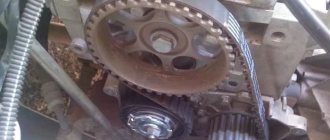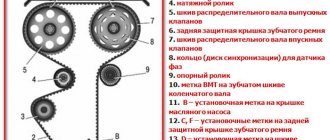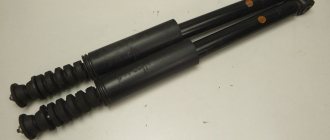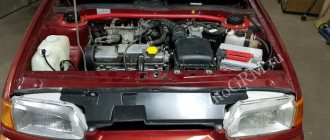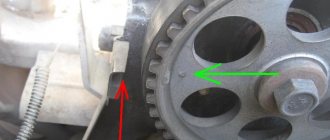The timing belt transmits force between the crankshaft and camshaft, and through toothed pulleys it ensures the correct settings of the unit. Damage to this element leads to a break, which, in turn, causes the pistons to collide with the valves, causing the latter to bend.
For proper engine operation, each owner must know at what interval the Renault Logan timing belt is replaced, and for what purpose the timing marks are adjusted.
We have collected all the necessary information regarding cars operating on eight- and sixteen-valve units in this material.
RENAULT 130-C-174-80-R – original timing kit for Logan K7M 8-valve engine
7701477014 – article number of the original timing repair kit for 16 valve Logan K4M (belt and two rollers)
Installing the piston of cylinder 1 at TDC
Timing mechanism drive: 1 - crankshaft toothed pulley;
2 — timing belt; 3 — tensioner roller; 4 — toothed pulley of the camshaft driving the exhaust valves; 5 — toothed pulley of the camshaft driving the intake valves; 6 — support roller; 7 - coolant pump toothed pulley Before starting to replace the Renault Logan timing belt, it is important to fix the piston of the first cylinder in the corresponding upper limit point of the compression stroke position - this will prevent failure of the gas distribution phase settings. Ignoring this nuance will result in the normal operation of the motor being disrupted.
Keep in mind that in the power plants that power Renault Logan, the first cylinder is considered to be located closer to the flywheel, and not to the wheel that drives the crankshaft assembly.
When setting TDC, follow the marks on the camshaft pulley.
The pulley fastening bolt is turned clockwise until the marks of the camshaft timing pulley and the head cover are aligned with the mark.
The adjustment is checked using a specially designed installation pin with a 75 mm thread. It is screwed into a hole in the cylinder block designed for an M10 thread. When scrolling the crankshaft, at the moment the piston reaches the upper limit position, the finger reaches the crankshaft cheek, which will block subsequent scrolling.
Timing marks Logan with K7M engine (8 valves)
Car repairs based on K7M engines are carried out using 10 mm and 18 mm socket heads.
Sequence of actions on Renault Logan cars:
- The necessary unit is hidden by the right wheel, so it is dismantled. The wheel locks are only released when the Logan is on the ground. Secure the wheels with wheel chocks, raise the handbrake, and secure the front of the car with a reliable support.
(link to photo source) - We approach the area of the engine hidden behind the right mudguard.
(link to photo source) - We remove the strap responsible for the operation of the auxiliary units. Before removing, it is recommended to mark on the outside the direction in which it moves, since incorrect installation will lead to accelerated wear of the element.
(link to photo source) - By turning the tensioner protrusion clockwise, remove the strap.
- We release the remaining pulleys from the drive that transmits movement to the auxiliary units.
- To replace the automatic tensioner, you need to unscrew the fixing bolt.
- Then we dismantle the right engine mount.
(link to photo source) - We open access to the power plant crankcase by removing the protection from it.
- Using a spacer, install the support under the crankcase.
- Remove the wiring harness holder from the right bracket;
- We remove the bolts securing the right support to the body.
- We unscrew the three fixing bolts that provide the connection between the right support and the power plant, and get rid of the support that interferes with the work.
- We ensure that the piston is fixed at TDC.
- After removing the bolts, remove the timing belt protective cover.
(link to photo source) - We adjust the timing belt marks by turning the belt pulley mounting bolt clockwise so that the marked place coincides with the place where the head cover is marked;
(link to photo source) - If the procedure is carried out correctly, the red letter A marked on the timing belt will coincide with the designation on the pulley housing.
- To ensure that the work is performed correctly, remove the pulley that ensures the movement of the auxiliary units.
(link to photo source) - We check the coincidence of the marks of the crankshaft gear and the block.
(link to photo source)
Timing belt marks for Logan K4M engine (16 valves)
When bringing the piston of the first cylinder of a sixteen-valve Renault Logan engine to the TDC position, the tool kit must be equipped with :
- Socket heads with dimensions of 15 and 18 mm;
- TORX E14 head;
- 13mm spanner wrench;
- Flat screwdriver;
- Clamps for crankshaft and camshaft units.
Algorithm of actions:
- We dismantle the bolts holding the front right wheel, we get the opportunity to get to the required unit by removing the wheel.
- We open access to the working space, freeing it from the right engine mudguard.
- Remove the accessory drive belt.
- Remove the right engine mount.
- We open the gas distribution mechanism drive by removing the top cover, which is mounted on three bolts and two nuts.
- By turning the bolt that secures the pulley, we set the timing marks, slightly not bringing them to the top point;
To fix Renault Logan camshafts, perform the following steps:
- We dismantle the intake resonator.
(link to photo source) - Using a flat-head screwdriver, pry up the camshaft plugs and remove them, pressing them out of the rear of the block.
(link to photo source) - If the piston is installed at TDC, the grooves located at the ends of the camshafts will be located horizontally, offset downward relative to the axis of the shafts;
- We install the camshaft retainer, maintaining this position of the grooves. If the position of the grooves is incorrect, the lock cannot be installed, so the valve timing is adjusted again.
(link to photo source)
Frequency and signs of replacement
According to the regulations stipulated by the manufacturer, the timing belt of Renault Logan cars is changed at a mileage of 60 thousand km or after 4 years of operation. In addition, it is recommended to inspect the drive parts and check and adjust the belt drive every 15 thousand mileage. And although the belt itself (provided it is original) easily runs for 90-120 thousand, it is not recommended to ignore the factory requirements. The fact is that the pistons of the 8-valve engines K7J, K7M do not have sufficient recesses for the valve plates. If the belt breaks, the meeting of the valves with the pistons will be fatal - they will simply bend and the engine will fail. The belt may require replacement earlier than expected. Here are the factors that lead to its premature wear:
- ingress of engine oil;
- excessive tension force;
- a non-original timing kit of low quality is used;
- jamming of the pump, tension roller or camshaft.
When carrying out routine maintenance after 15 thousand mileage, you should definitely inspect the belt, even if the time for its replacement is still far away. Signs indicating that the product is about to fail:
- cracks;
- material delamination;
- separation of cord threads;
- deformation changes in the form of bends, folds;
- wear or damage to individual teeth;
- oiling
Changing the Renault Logan timing belt
The Renault Logan timing belt has a fairly short lifespan , so the moment when it needs to be changed comes after 60 thousand km that the car travels.
Replacing the timing belt Renault Logan 8 valves (K7M)
In addition to the set of tools with which the piston of the 1st cylinder was installed at TDC, a wrench with a dimension of 10 mm . The tensioner is turned with a special wrench or pliers with bent jaws.
Actions when replacing a used Renault Logan belt:
- After installing the piston at top dead center, disconnect the accessory drive wheel and the crankshaft.
- We remove the lower part of the timing cover, secured with three bolts.
(link to photo source) - Make marks, based on which, during installation you will be able to determine the correct position of the tensioning element, after which, loosening the fixing nut, turn the tensioner clockwise.
- In order of priority, release the pulleys of the water pump, camshaft and crankshaft, as well as the tensioner mechanism from the belt.
(link to photo source) - When changing the tensioner, please note that the element is installed with the key holes facing outward.
- The new belt is fixed according to the direction of movement of the element indicated by the arrows during engine operation, starting with the camshaft toothed pulley, then transferred to the pulleys of the water pump, crankshaft and tensioner.
- By turning the roller counterclockwise, we ensure the belt tension.
- Tighten the tensioner fixing nut.
- Attach the wheel that transmits movement to the mechanisms of the auxiliary elements to the crankshaft, rotate the shaft 2 times and make sure that the marks that regulate the correct position of the camshaft and crankshaft pulleys match.
- Pay attention to the degree of tension of the timing belt. If the drive link twists 90 degrees or more, the tension is loose.
- After aligning the marks and checking the tension, remove the pulley that drives the auxiliary units;
- Reinstall all dismantled elements.
Replacing the timing belt Logan 16 valves (K4M)
Replacing the timing belt on an aggregated sixteen-valve Renault Logan engine is done with the tools included in the kit for installing the piston at TDC, using a 10-mm socket and a 6 mm hexagon.
How to change the belt:
- After installing the TDC piston, remove the auxiliary wheel by removing the corresponding bolt.
- Remove the belt protection cover by unscrewing the corresponding fasteners.
(link to photo source) - Install the hexagon into the corresponding groove of the tension roller so that it does not rotate when the nut is loosened.
- After removing the timing belt, get rid of the roller mounting nut.
- Remove the belt intermediate roller secured with a bolt and washer.
- When installing a new tension element, the protrusion must fit into the groove of the motor. To tighten the nut, a force of 7 Nm is required.
- We tighten the Renault Logan timing belt.
- When fixing the roller with a hexagon, you need to move the movable mark protruding on the outer part of the tensioner body 7-8 mm clockwise.
(link to photo source) - Install the wheel that transmits movement to the auxiliary mechanisms, then remove the auxiliary fixing elements of the crankshaft and camshaft.
- Wrap the bolt securing the accessory wheel and crankshaft 6 times.
- We loosen the nut responsible for fixing the tensioning mechanism, and bring the movable mark to the fixed one. We tighten the fastening with a torque wrench, applying a force equal to 27 Nm;
- Using the method of installing the piston of the 1st Logan cylinder at TDC, check whether the gas distribution phases are adjusted correctly;
- Collect all dismantled elements.
Articles
Belt + Tensioner Pulley Kit for Various 8-Valves:
- For internal combustion engine K7M (K7J) 710-7701477024, width 17.3 mm, number of teeth 96;
- For internal combustion engine K7M (K7J) 800 - 130C17480R. The difference between the two sets is small. The belts are the same, the rollers are different.
Set “belt + two rollers (tensioner, guide)” for 16-valve gasoline engines:
- K4M 690 or 697 - 130С17529R, 27.4 mm, 132 teeth.
All items are taken from the Renault catalog.
Kit for 16 valves
2271-3-8-06-09
We insert a mounting blade through the window in the clutch housing between the teeth of the flywheel ring intended for starting the engine with the starter.
Attention! Be careful not to damage the surface of the teeth needed to operate the crankshaft position sensor (they are much larger).
And now the easiest way
We set the camshaft mark simply up. We specially adjusted the old mark on the timing belt for clarity. The mark on the belt may not match due to the fact that the belt arms between the marks are different and with each revolution it will shift by two teeth. If it suffers, then after a certain number of revolutions all the marks will fall into place, but we don’t need this.
The circled icon will be needed if we are going the long way; more about it at the end of the article.
If the old mark on the belt and camshaft match, then the second one on the belt and crankshaft too.
If you have a newer Logan, the camshaft sprocket will look like this.
And here one nuance arises: in order to pull out the belt, you will have to move the sprocket toward you, using a special puller or a homemade device.
We mark the marks on the belt with a marker; if they are not preserved, we remember which camshaft. Loosen the tension roller nut and remove the belt along with the roller.
For the new generation, the roller is already automatic and the belt is tensioned until the indicator matches the cutout on the roller, always in the direction indicated by the arrow on the roller.
The new timing belt has marks and direction of movement.
We apply the old belt to the new one and are amazed at how clearly all the marks match.
We put the new timing belt in place, aligning the marks on the belt with the marks on the camshaft and crankshaft. We tighten it with a roller using the usual VAZ device. We check the tension of the belt, turn the long branch with two fingers and if it can be turned more than ninety degrees, then tighten it again. That's all. You can put back everything that was removed earlier.
2271-3-8-06-04
With normal belt tension, the movable pointer should coincide with the recess of the fixed pointer of the tensioner (for clarity, shown with the lower timing cover removed).
If the moving pointer is offset relative to the fixed one:
- counterclockwise - belt tension is insufficient;
- clockwise - the belt will be tightened.
In both cases, the belt tension should be adjusted.
It is impossible to start the car, even though the starter is working.
This is the final stage of possible problems. If you haven’t discovered a problem with the timing belt before and it still bursts or breaks, then finding out will be as easy as shelling pears. When you try to start the engine, the starter performs its function flawlessly, even better than always, but the engine does not start. This is an indicator that there is no pickup and ignition of the air-gasoline mixture, and this occurs due to the bending of the valves after meeting the pistons. This problem can be solved in two ways: Complete replacement of the engine with a normally functioning one (disassembled or new) Major repairs in a car service, in both cases these are quite expensive procedures.
(3 votes, average: 3.3 out of 5)
And now the hard way
We place a mark on the camshaft opposite the icon on the cylinder head, which was circled in the previous photo. This is top dead center. Unscrew the plug on the cylinder block.
We screw in a special tool, which is a bolt with an M10 thread and a long thread of 75 mm. We tighten it instead of the plug, thereby locking the crankshaft at top dead center. We install a new timing belt and tension it. And the question arises: why these extra operations?
About the resource
The manufacturer notes the norm at 90 thousand kilometers. However, experience shows that the resource of this belt is less than 60 thousand. At this time he has serious cracks and tears. When even a tutorial appears, a complete belt replacement is required. When the generator also runs on a belt drive.
Renault Logan (Special battery) is charged on the fly by the energy of the crankshaft rotation. The resource of this element is more than 100,000. The main feature. It's a belt whistle. The generator doesn't work here. Renault Logan" Discharges quickly.
Currently reading: Renault Logan 1 rear brake pads
As for the timing drive, its strap is worn around the teeth. In particular, it experiences heavy loads at high speeds. When an element jumps 1 tooth. For this reason, the valve response time is shifted. Malfunctions are observed, the car consumes more than just fuel. Power and dynamics are greatly reduced.
Please note that a timing belt drive is not installed on the Renault Logan 1.4. Here the chain is used as a driving mechanism. It's more reliable. For about 30 years, 90% of these vehicles have been used. The network resource drive is about 300 thousand. However, replacing it is much more difficult. And a Renault Logan is much noisier than one with a belt.
What to be afraid of when the last one is cut off? This is basically a faulty valve. There is a risk of engine damage. "Renault Logan", A very reliable car, but the valves are open when the piston is at TDC. And so both elements come into contact. The valve is bent. The following picture emerges.
The cost of repairs here is comparable to half the cost of the motor itself. To preserve the valve mechanisms, it is necessary to regularly check the condition of the belt (at least every 15 thousand kilometers). Replace if desired.
